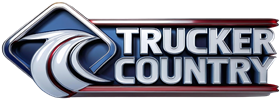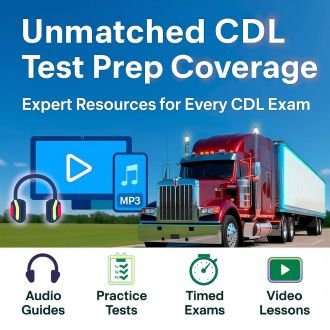Updated 2025. Truck drivers communicate with other drivers, customers, and officials all day long. CB is still the fastest way to reach nearby drivers, but lights/signals and posted yard channels matter too. Below is the practical playbook—short, clear, and driver-first.
Communicating Trucker-to-Trucker
Information keeps freight moving. When you key up, offer useful info first—then ask what you need.
- Share first: “WB I-80 looks clear after Omaha, light rain only.” Then ask, “How’s EB to Des Moines?”
- Late night / rural: Longer chats are fine when traffic is light—just keep 19 usable if things get busy.
- Learn openly: Don’t hide that you’re new. Ask questions and improve. Everyone started at zero.
Information to Share (High-Value)
- Adverse weather: fog bands, high winds, ice, heavy rain, whiteouts.
- Accidents & hazards: brake-checks, lane blocks, debris (“alligators”), vehicles/people on shoulder.
- Bear reports: “Bear on shoulder with a customer at MM 191.” Helps drivers plan lane changes safely.
- Local directions: shippers/receivers, truck stops, restaurants with truck parking.
Courtesy on the Road (Helping Each Other)
- Warn trailing traffic: If hazards are ahead and you can’t safely move over, call it out on 19 and reduce speed early.
- Announce brake-checks: A quick “Brake check SB 75 at 181—right two blocked” gives time for safe slows.
- Help with lane changes: Give space. A short, clear “Come on around” beats guesswork and brake smoke.
- Passing courtesy: If a truck struggles to pass, easing off a couple mph (when safe) clears the pass for everyone. But not if there's another vehicle right behind you. That'll might just confuse them. 🙂
Headlight flash note: Some drivers briefly blink headlights to signal “you’re clear.” Regulations and liability can be tricky—avoid signaling in ways that could shift responsibility for the maneuver. Use the radio when possible, and let the passing driver make the call.
Intersections & Tight Turns
Arriving with another truck at the same time? Hang back and say “Go ahead” on the CB (or a brief headlight blink) so they can make the swing. Big turns need room.
(Not all trucks run CB, and even equipped trucks don’t always keep it on. Keep your volume low—the important calls still cut through.)
Channel Conventions
- 19: national road info on most interstates.
- 17: used in parts of the West for E–W routes (varies—check both 17 & 19).
- 9: traditional emergency/monitor channel in some regions; follow local practice.
- Yards/scales/customers: many post a working channel at the gate, scale house, or shipping office.
- Long conversations: move off 19 to a clear working channel when you can.
Mic Technique & Radio Setup
- Mic distance: 1–2″ from mouth, slightly off-axis; normal voice. Avoid shouting and breathing on the mic.
- RF Gain: start high; back down only if you’re pulling in too much distant noise.
- Squelch: turn counter-clockwise until you hear static, then clockwise until the noise just clears.
- Noise filters: ANL/NB/HI-CUT help in loud cabs—don’t overdo or you’ll clip weak signals.
- Antenna/SWR: a tuned antenna (SWR ≤ 1.5:1) beats a fancy radio with a poor antenna every time.
Yards, Scales & Customers
- Public scales/fuel desk: Watch for posted channel; have unit number and company ready for the ticket.
- Gate guards: They may call by truck number and direct you to staging or a specific door.
- Shippers/receivers: Some assign docks over CB; others use phones/text—follow signage and instructions.
Emergencies & Safety Calls
- Crash/hazard: route, mile marker, direction, lane, and what’s in the road—short and specific.
- Disabled vehicle: “Disabled tractor-trailer on right shoulder, WB I-40 at MM 221, triangles out.”
- Severe weather: report wind advisories, ice/fog bands, whiteouts, and chain controls as you encounter them.
Sample Voice Scripts
Hazard: “Brake-check southbound 75 at one-eighty-one — wreck on the shoulder, debris in right lane.”
Passing help: “Come on around, driver — you’ve missed me".”
Dock check-in: “Shipping, Blue Star thirteen-forty-seven at the gate for ten A.M. pickup.”
Signals Using Lights & Flashers
- Lane change intent: brief turn signal early, steady pace, then go when space opens (don’t force it).
- Shoulder hazards: move over early when safe; if not, slow and call it out on 19 so following traffic isn’t surprised.
- Headlight courtesy: some drivers toggle lights to acknowledge a completed pass—use sparingly; radio is clearer.
Legal & Modes (U.S.)
- Power: 4 W AM/FM; 12 W PEP on SSB. External amplifiers are not permitted on CB.
- Channels: 40 CB channels. FM mode is allowed on supported radios.
- License: None required for CB; follow FCC rules and local restrictions.
For radio hardware, setup, and current units, see the CB Radio Guide. For the lingo, open CB Slang & 10-Codes (A–Z).


